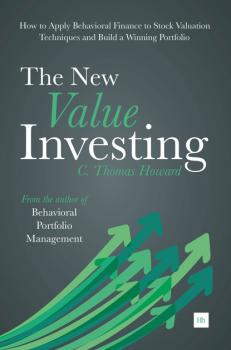C. Thomas Howard
Список книг автора C. Thomas HowardThe New Value Investing
The aim of value investing is to identify stocks that are undervalued and which can be expected to produce an above average return in the future. And the message from the history of investing is clear: if you successfully pursue a value investing strategy over the long term, you will earn an above average return on your portfolio. The goal of <i>The New Value Investing</i> is to help you identify undervalued stocks and teach you how to build your own successful value investing portfolio.
Added to this, it is important to understand that value investing is inextricably linked with behavioral finance, and research advances in this area in recent years strengthen the case for value investing. The author explains how stock prices are determined by emotional crowds, how this leads to mispriced stocks and opportunities for the value investor, and how you can harness the insights of behavioral finance to improve your value investing approach.
As you work through this book, the author shows how to follow the path from analysis of the economy, to the industry, to company financial statements, to creating a value range for a company's stock. You will learn:
– How to remove emotion from your investment process. – The essential elements of portfolio construction. – What a value investor should observe in the wider economy and the market. – Where to find investment ideas. – How to read a company's financial statements from a value investing perspective. – Dividend valuation, earnings valuation and other valuation techniques. – How to undertake a full valuation analysis, with two complete worked examples of stock valuation for real-life companies. – What professional value investors at investment funds analyse and how they make their decisions.
Value investing is within everyone's reach, so why doesn't everyone use it? The key is patience. The approach works over the long term if you stick with it and the result could be extra hundreds, thousands or millions in your portfolio at the end of your investment horizon.
Return of the Active Manager
Emotional behavior and biases run throughout financial markets. This is the diagnosis of behavioral finance.
But it is not enough to know that investors make biased decisions. What do we do about it? How do we move beyond diagnosis, to prescription?
In this groundbreaking new book, investing and behavioural finance experts Thomas Howard and Jason A. Voss plug this void and show the new way ahead for investment managers and advisors. <i>Return of the Active Manager</i> provides a set of tools for investment professionals to overcome and take advantage of behavioral biases.
Across seven compelling chapters, <i>Return of the Active Manager</i> details actionable advice on topics such as behaviourally-enhanced fundamental analysis, active equity fund evaluation and selection, harnessing big data, and investment firm structure. You learn how to exploit behavioural price distortions, how to recognise and avoid behavioural biases (in both yourself and clients), how to extract behavioral insights from the executives of prospective investments, and how manager behaviour can be used to predict future fund performance.
An indispensable tool, <i>Return of the Active Manager</i> rationalises the financial markets and prescribes actionable strategies that build on the lessons of behavioural finance.
Behavioral Portfolio Management
The investment industry is on the cusp of a major shift, from Modern Portfolio Theory (MPT) to Behavioral Finance, with Behavioral Portfolio Management (BPM) the next step in this transition. BPM focuses on how to harness the price distortions that are driven by emotional crowds and use this to create superior portfolios. Once markets and investing are viewed through the lens of behavior, and portfolios are constructed on this basis, investable opportunities become readily apparent.
Mastering your emotions is critical to the process and the insights provided by Tom Howard put investors on the path to achieving this. Forty years of Behavioral Science research presents a clear picture of how individuals make decisions; there are few signs of rationality. Indeed, emotional investors sabotage their own efforts in building long-horizon wealth. When this is combined with the misconception that active management is unable to generate superior returns, the typical emotional investor leaves hundreds of thousands, if not millions, of dollars on the table during their investment lifetimes.
Howard moves on to show how industry practice, with its use of the style grid, standard deviation, correlation, maximum drawdown and the Sharpe ratio, has entrenched emotion within investing. The result is that investors construct underperforming, bubble-wrapped portfolios. So if an investor masters their own emotions, they still must challenge the emotionally-based conventional wisdom pervasive throughout the industry. Tom Howard explains how to do this.
Attention is then given to measureable and persistent behavioral factors. These provide investors with a new source of information that has the potential to transform how they think about portfolio management and dramatically improve performance. Behavioral factors can be used to select the best stocks, the best active managers, and the best markets in which to invest.
Once the transition to behavioral finance is made, the emotional measures of MPT will quickly be forgotten and replaced with rational concepts that allow investors to successfully build long-horizon wealth. If you take portfolio construction seriously, it is essential that you make the next step forward towards Behavioral Portfolio Management.


